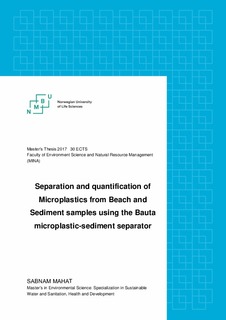| dc.contributor.advisor | Almås, Åsgeir R. | |
| dc.contributor.advisor | Arp, Hans Peter | |
| dc.contributor.author | Mahat, Sabnam | |
| dc.coverage.spatial | Norway, Oslo | nb_NO |
| dc.date.accessioned | 2017-10-09T09:10:07Z | |
| dc.date.available | 2017-10-09T09:10:07Z | |
| dc.date.issued | 2017 | |
| dc.identifier.uri | http://hdl.handle.net/11250/2459114 | |
| dc.description.abstract | Microplastic pollution is a topic of scientific interest globally. The environmental impacts caused by microplastics have spurred research focusing on separation and quantification of microplastics from soil and sediments in both fresh and marine waters. Different approaches are used for studies and continuous improvements are made, thus developing a reliable, standardized separation and quantification method has been a challenge. The Bauta microplastic-sediment separator, based on the concept of Munich plasticsediment separator, was constructed at NGI, Oslo. An optimized separation protocol was developed using different dense solutions, and a range of laboratory microplastics (lab MP): LDPE pellets, PE fibers, HDPE pellets and PET powder. Optimized method includes the use of Zinc chloride and Calcium chloride solution (d ~1.6 g/mL) as separation solution and a steel mesh (45µm) as filter. Laboratory sand (0.2-0.7 mm, d =2.6 g/mL) and beach sand (> 200 µm, d > 1.6 g/mL) were spiked with the lab MP to obtain recovery rates. Organic matter separated with the MP were dissolved following a digestion protocol which uses sodium hydroxide: urea: thiourea solution for dissolution, followed by 30% hydrogen peroxide and 10M sodium hydroxide for oxidization of organic matter. Microplastics (< 8mm and > 45m) from environmental samples: beach plastic debris from Bygdøy sjøbad and effluent sediment from Bekkelaget WWTP were also separated. Spiking resulted in lower recovery rates of PE fibers from lab sand and beach sand (77 ± 0.05 (s.d) % and 82 ± 0.10% respectively). The beach sand from Bygdøy sjøbad had a significant difference (p < 0.05) for the concentration of MP and hard-to-digest organic matter; the difference was found between the high-water mark (HWM) region and HWM -6m region, also between HWM and HWM +6m region. Bekkelaget WWTP samples had an average MP concentration of 27.92 ± 37.37 mg/kg. This novel technique is a reliable approach to separate microplastics from soil and sediments. Microplastics were present in Bekkelaget WWTP sediment and Bygdøy sjøbad debris samples. The concentration of MP was highest at the high-water zone. Advanced quantification of the separated microplastics based on their polymers should be performed using available identification techniques. This study will aid as an information tool for further optimization and development of more accurate separation, filtration, quantification and identification methods for microplastics from soil and sediments. | nb_NO |
| dc.description.abstract | Bauta mikroplastisk sediment separator, basert på konseptet av plast-sediment separator i München, ble konstruert ved Norges Geoteknisk Institutt, Oslo. En optimalisert separasjonsprotokoll ble utviklet basert på tester ved bruk av løsninger med forsjellig tetthet og laboratoriemikroplaster: LDPE-pellets, PE-fibre, HDPE-pellets og PET-pulver. Separasjonsprotokollen inkluderte bruken av sinkklorid og kalsiumkloridoppløsning (d ~ 1,6 g / mL) som separasjonsløsning og en stålmaske (45 μm) som filter. Mikroplastikk fra laboratoriet ble tilsatt laboratorie sand (0,2-0,7mm, d=2,6 g/mL) og strand sand (vasket Bygdøy sjøbad strand samlet sand, > 200 μm, d> 1,6 g / mL) for å få utvinningsrate. Fordøyelsesprotokollen inneholdt bruk av en løsning av natriumhydroksid, urea og tiourea for oppløsning, etterfulgt av 30% hydrogenperoksid og 10M natriumhydroksyd for oksidasjon av organisk materiale. Videre ble de optimaliserte metodene brukt til å skille mikroplastikk (<8 mm og >45 μm) fra miljøprøver: strand sand fra Bygdøy sjøbad og avløpssement fra Bekkelaget avløpsrensingsanlegg.
Tilsetting av mikroplastikk resulterte i forholdsvis lavere utvinningshastigheter av PE fibre fra laboratoriesand og strandsand (77 ± 0,05% s.d og 82 ± 0,10% s.d). Prøvene fra Bygdøy sjøbad hadde en signifikant forskjell (p < 0,05) for konsentrasjonen av mikroplastik og vanskelig å fordøye organisk materiale; forsjellen ble funnet mellom HWM-regionen og HWM-6m-regionen, og mellom HWM og HWM + 6m-regionen. Tilstedeværelsen av mikroplastikk ble verifisert i Bekkelaget WWTP-prøver med en gjennomsnittskonsentrasjon på 27,92 ± 37,37 mg / kg.
Denne nye teknikken er en pålitelig tilnærming til å separere mikroplastikk fra jord og sedimenter. Hypotesene viste seg å stemme, mikroplastikk er tilstede i strender der det ikke finnes tilsynelatende lokale kilder, og i avløpet fra Bekkelaget avløpsvannbehandling. Avansert kvantifisering av de adskilte mikroplastikene basert på deres polymerer bør utføres ved hjelp av utviklede identifikasjonsteknikker. Videre vil denne studien være et informasjonsverktøy for videre optimalisering og utvikling av mer nøyaktige separasjons-, filtrerings-, kvantifiserings- og identifiseringsmetoder for mikroplastikk fra jord og sedimenter. | nb_NO |
| dc.language.iso | eng | nb_NO |
| dc.publisher | Norwegian University of Life Sciences, Ås | nb_NO |
| dc.rights | Attribution-NonCommercial-NoDerivatives 4.0 Internasjonal | * |
| dc.rights.uri | http://creativecommons.org/licenses/by-nc-nd/4.0/deed.no | * |
| dc.title | Separation and quantification of microplastics from beach and sediment samples using the Bauta microplastic-sediment separator | nb_NO |
| dc.type | Master thesis | nb_NO |
| dc.description.localcode | M-MINA | nb_NO |

